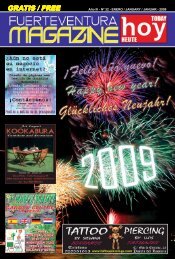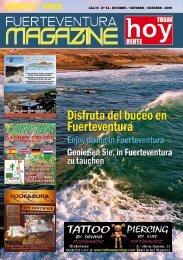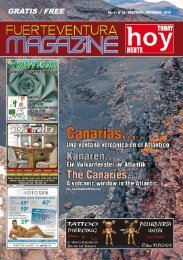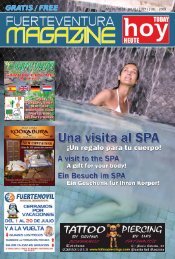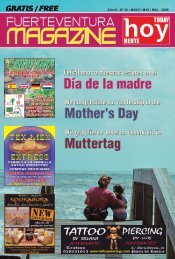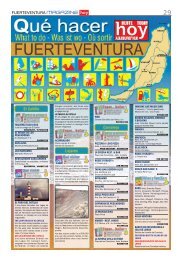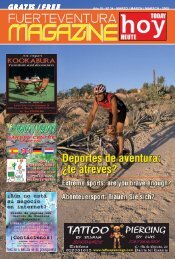GRATIS / FREE - fuerteventura magazine hoy
GRATIS / FREE - fuerteventura magazine hoy
GRATIS / FREE - fuerteventura magazine hoy
Create successful ePaper yourself
Turn your PDF publications into a flip-book with our unique Google optimized e-Paper software.
FUERTEVENTURA MAGAZINE <strong>hoy</strong><br />
ARTE Y CULTURA / ART AND CULTURE / KUNST UND KULTUR<br />
María Sanz Esteve – Prize winner of the award for best director for her short<br />
film called Serendipia<br />
“Fuerteventura, main character on the big<br />
screen”<br />
FMHOY - Fuerteventura<br />
Fuerteventura is back on the national cinema<br />
screens. And this time not only as the scenery but<br />
as the main character.<br />
The event is due to the short film “Serendipia”<br />
being awarded the Premio del Público Madrid 2010<br />
which is the first film that María Sanz Esteve directed<br />
within the 13th Curt Ficcions short film Festival. The<br />
prize which does not consist of any financial reward,<br />
offers for two copies in 35 millimetres of the film to<br />
be made so that the film can be shown in cinemas in<br />
over 20 Spanish towns during one year, which would<br />
otherwise be unfeasible for this type of film.<br />
The director granted us a few minutes of her time<br />
to give us a few details about her cinematographic<br />
path and her work.<br />
María Sanz Esteve has been a resident on the<br />
island for 10 years, she was born in Madrid and graduated<br />
in Sciences of Image although she confirms<br />
that she didn’t learn from university what she knows<br />
about cinema. Her restlessness and almost obsessive<br />
passion about cinema from a very young age made<br />
her move to London as soon as she graduated from<br />
University. She lived there for 7 years completely<br />
immersed in any opportunities of work or activities<br />
related to cinema and she finally managed to access<br />
the city’s film library,- she tells us enthusiastically-<br />
where in addition to being able to watch as much<br />
cinema as she wanted, from the greatest masters in<br />
the world…they used to pay her to do it! – from this<br />
moment on, she participated in various productions<br />
as production assistant, director’s assistant, extras’<br />
coordinator, dressing room manager, decorator and<br />
even driver of the electronics and machinists truck,<br />
which she had to pass the appropriate licence for… -<br />
This was her best school and allowed her to find out<br />
in depth about every aspect of cinema. She then<br />
moved to Fuerteventura where she says she found the<br />
perfect environment to develop her creativity without<br />
the influence of globalisation.<br />
The idea of “Serendipia” came from a micro-tale of<br />
the Ecuadorian writer, who lives in the Canaries, Patricia<br />
Sacoto… “A child walks in an immense desert. To reach<br />
the shop and come back can be a blessing or a nightmare.<br />
Sometimes it only depends from each person’s own<br />
perspective”. Set on the island of Fuerteventura in the<br />
50’s, “Serendipia” can be seen as universal story about<br />
difficult times… The story tells about the return trip of<br />
Carmencita to a shop to buy a few groceries in order to<br />
feed her family… María tells us that it is a fiction based<br />
on a true story, a tale or a trip, where the good and the<br />
bad sides of life are not always clear.<br />
For the production, the director recalls that she<br />
31<br />
was able to rely on a great team of professionals and<br />
unconditional enthusiasts, whose input was indispensible.<br />
The production was paid by Dunes Films,<br />
a production company created by María three years<br />
ago, which is sponsored by the Canarian Government<br />
and benefits from the participation of Ventura Films<br />
and Sebastián Álvarez as associate producers and<br />
the collaboration of Fuerteventura’s Cabildo. Asiria<br />
Suárez Álvarez got the role of Carmencita; Soledad<br />
Aguiar Montelongo was Señá Manuela and Lorenza<br />
Machín interpreted Abuela. Furthermore, some residents<br />
of the island appeared in the story such as<br />
Suso Machín or María Jesús Martínez Ruíz (the true<br />
protagonist of this story). The music creation consisted<br />
of an original sound track from Miguel Pérez Díaz<br />
and the introduction of themes given by the Majoreo<br />
Timple player Domingo Rodríguez “El colorao” and the<br />
group from Tenerife called “Non Trubada”.<br />
After our chat with María and seeing in her eyes the<br />
emotion brought back with memories of the production,<br />
filming and editing of her prized short-film, we now understand<br />
why it is called the 7th art (although it is difficult<br />
to really understand the reason for its seventh ranking).



